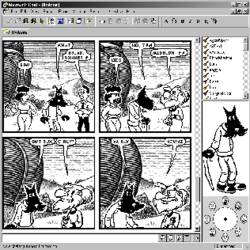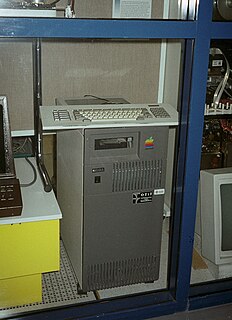
Internet Relay Chat (IRC) is a text-based chat system for instant messaging. IRC is designed for group communication in discussion forums, called channels, but also allows one-on-one communication via private messages as well as chat and data transfer, including file sharing.
ICQ New is a cross-platform instant messaging (IM) and VoIP client. The name ICQ derives from the English phrase "I Seek You". Originally developed by the Israeli company Mirabilis in 1996, the client was bought by AOL in 1998, and then by Mail.Ru Group in 2010.
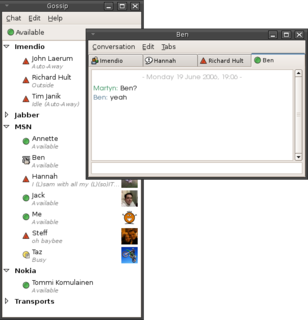
Instant messaging (IM) technology is a type of online chat allowing real-time text transmission over the Internet or another computer network. Messages are typically transmitted between two or more parties, when each user inputs text and triggers a transmission to the recipient(s), who are all connected on a common network. It differs from email in that conversations over instant messaging happen in real-time. Most modern IM applications use push technology and also add other features such as emojis, file transfer, chatbots, voice over IP, or video chat capabilities.
Trillian is a proprietary multiprotocol instant messaging application created by Cerulean Studios. It is currently available for Microsoft Windows, Mac OS X, Linux, Android, iOS, BlackBerry OS, and the Web. It can connect to multiple IM services, such as AIM, Bonjour, Facebook Messenger, Google Talk (Hangouts), IRC, XMPP (Jabber), VZ, and Yahoo! Messenger networks; as well as social networking sites, such as Facebook, Foursquare, LinkedIn, and Twitter; and email services, such as POP3 and IMAP.

Yahoo! Messenger was an advertisement-supported instant messaging client and associated protocol provided by Yahoo!. Yahoo! Messenger was provided free of charge and could be downloaded and used with a generic "Yahoo ID" which also allowed access to other Yahoo! services, such as Yahoo! Mail. The service also offered VoIP, file transfers, webcam hosting, a text messaging service, and chat rooms in various categories.

Miranda NG is an open-source multiprotocol instant messaging application, designed for Microsoft Windows. Miranda NG is free software distributed under the GNU GPL-2.0-or-later.

Bersirc is a discontinued open-source Internet Relay Chat client for the Microsoft Windows operating system. Linux and Mac OS X versions were "in development". Bersirc uses the Claro toolkit, which aims to provide an interface to native windowing systems and widgets on all operating systems. Microsoft .NET and Qt toolkit ports were also planned. The final version of Bersirc was 2.2.14.

Internet Explorer for Mac OS X is a proprietary web browser developed by Microsoft for the Macintosh platform to browse web pages. Initial versions were developed from the same code base as Internet Explorer for Windows. Later versions diverged, particularly with the release of version 5, which included the cutting-edge, fault-tolerant and highly standards-compliant Tasman layout engine.

Google Talk was an instant messaging service that provided both text and voice communication. The instant messaging service was variously referred to colloquially as Gchat, Gtalk, or Gmessage among its users.
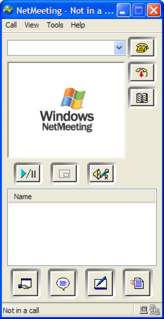
Microsoft NetMeeting is a discontinued VoIP and multi-point videoconferencing client included in many versions of Microsoft Windows. It uses the H.323 protocol for videoconferencing, and is interoperable with OpenH323-based clients such as Ekiga, OpenH323, and Internet Locator Service (ILS) as reflector. It also uses a slightly modified version of the T.120 Protocol for whiteboarding, application sharing, and file transfers.

Microsoft Internet Explorer 4 (IE4) is a graphical web browser that Microsoft unveiled in Spring of 1997, and released in September 1997, primarily for Microsoft Windows, but also with versions available for the classic Mac OS, Solaris, and HP-UX and marketed as "The Web the Way You Want It".

Microsoft Internet Explorer 3 (IE3) is a graphical web browser which was announced in March 1996, and was released on August 13, 1996 by Microsoft for Microsoft Windows and on January 8, 1997 for Apple Mac OS. It began serious competition against Netscape Navigator in the first Browser war. It was Microsoft's first browser release with a major internal development component. It was the first more widely used version of Internet Explorer, although it did not surpass Netscape or become the browser with the most market share. During its tenure, IE market share went from roughly 3–9% in early 1996 to 20–30% by the end of 1997. In September 1997 it was superseded by Microsoft Internet Explorer 4.
MSN Chat was the Microsoft Network version of IRCX, which replaced Microsoft Chat, a set of Exchange-based IRCX servers first available in the Microsoft Comic Chat client, although Comic Chat was not required to connect.

Messenger Plus! is an add-on for Windows Live Messenger and Skype. The software provides additional functionality to Microsoft's Instant messaging client, Windows Live Messenger, by adding its own controls to the main interface. These controls affect Messenger's behaviour and appearance, often through additional dialog boxes.
Skype offers a number of features based around calling, messaging, video chat, and file and screen sharing. The following is a partial list of Skype's features:

MSN Messenger, later rebranded as Windows Live Messenger, was a cross-platform instant-messaging client developed by Microsoft. It connected to the Microsoft Messenger service and, in later versions, was compatible with Yahoo! Messenger and Facebook Messenger. Versions were developed for Windows, Xbox 360, Mac OS X, BlackBerry OS, iOS, Java ME, S60 on Symbian OS 9.x, MSN TV, Zune HD, Windows Phone, Windows Mobile and Windows CE.
Slenfbot is the classification for a family of malicious software (malware), which infects files on Microsoft Windows systems. Slenfbot was first discovered in 2007 and, since then, numerous variants have followed; each with slightly different characteristics and new additions to the worm's payload, such as the ability to provide the attacker with unauthorized access to the compromised host. Slenfbot primarily spreads by luring users to follow links to websites, which contain a malicious payload. Slenfbot propagates via instant messaging applications, removable drives and/or the local network via network shares. The code for Slenfbot appears to be closely managed, which may provide attribution to a single group and/or indicate that a large portion of the code is shared amongst multiple groups. The inclusion of other malware families and variants as well as its own continuous evolution, makes Slenfbot a highly effective downloader with a propensity to cause even more damage to compromised systems.
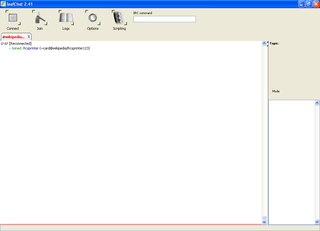
LeafChat is a free IRC client for Microsoft Windows and Unix-like operating systems, licensed under the GNU GPL-3.0-or-later. A donation is requested.

MSN Dial-up is an Internet service provider operated by Microsoft in the United States and formerly also in several other countries. Originally named The Microsoft Network, it debuted as a proprietary online service on August 24, 1995, to coincide with the release of Windows 95. In 1996 and 1997, a revised web-based version of the ISP was an early experiment at interactive multimedia content on the Internet.

Vision is an IRC client for BeOS.
